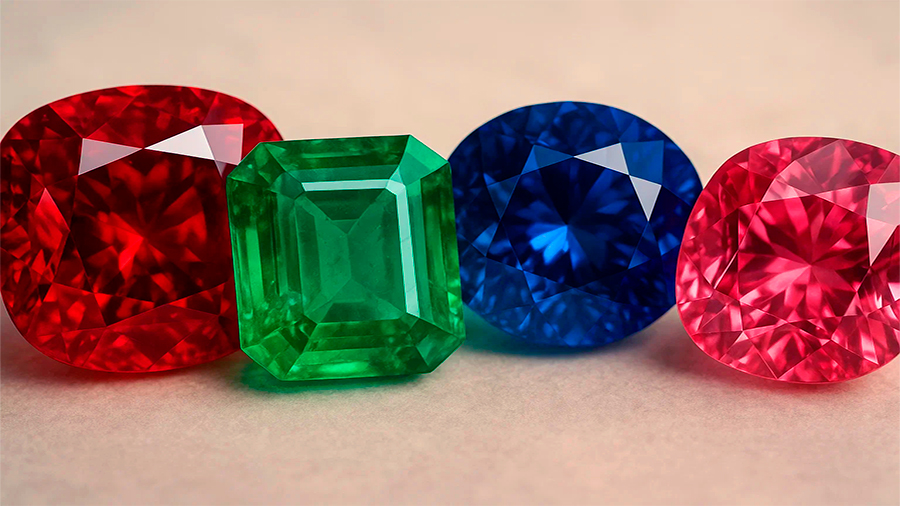December 01, 2025
Colored Gemstones As Investments: Growth Trends And Challenges

Colored Gemstones: The Rising Stars Of The Investment Market
For centuries, white diamonds dominated the world of luxury and investment. They were marketed as eternal symbols of wealth, romance, and stability. Yet in recent years, a quiet revolution has been unfolding. Colored gemstones—rubies, emeralds, sapphires, and even once-overlooked varieties like spinels—are attracting attention from investors, collectors, and global markets. Their rarity, cultural value, and growing demand have positioned them as serious competitors to traditional diamonds. Understanding why these vibrant stones are rising in value reveals both the opportunities and the risks that come with investing in this evolving market.
The Shift From Diamonds To Colored Gemstones
Diamonds owe much of their dominance to marketing campaigns of the 20th century. However, supply chains, changing consumer tastes, and broader cultural trends are reshaping preferences. Wealthy buyers in Asia, the Middle East, and Europe increasingly see colored stones as symbols of individuality and prestige. Rubies, emeralds, and sapphires, each with unique qualities, are prized for their scarcity compared to diamonds. Unlike diamonds, which are mined in large quantities and graded by relatively standardized systems, fine-colored gemstones are far rarer and less commoditized. This scarcity has made them attractive to investors seeking diversification.
Consumer Tastes As A Market Driver
Younger generations of wealthy consumers want exclusivity and differentiation rather than tradition. Owning a rare gemstone that cannot be easily replicated appeals more than following older trends of diamond engagement rings. This cultural shift is fueling demand and driving prices upward.
Performance Of Colored Gemstones Compared To Diamonds
Over the past decade, price trends have highlighted the growing strength of colored stones in investment portfolios. While white diamonds have experienced stagnation or moderate growth, rubies, emeralds, and spinels have shown double-digit appreciation in some markets. Auction houses report record-breaking sales of top-quality colored stones, while diamonds of equivalent carat weights often underperform. The rarity of fine, untreated gemstones contributes to this outperformance, creating conditions where demand consistently outpaces supply.
Data From International Auctions
Major auction houses such as Christie’s and Sotheby’s have reported significant increases in colored gemstone sales. Exceptional rubies from Myanmar or emeralds from Colombia often command higher prices per carat than top-grade white diamonds, reflecting their rarity and desirability.
Comparison Of Investment Performance: Diamonds vs. Colored Gemstones
The following table illustrates how select colored gemstones compare with white diamonds in terms of value trends and characteristics:
| Asset | Rarity | Value Growth (Last Decade) | Market Characteristics |
|---|---|---|---|
| White Diamonds | Relatively abundant, standardized grading | Low to moderate growth | Highly commoditized, large global supply |
| Rubies | Extremely rare in high quality | High growth, record auction sales | Strong cultural value in Asia, limited supply |
| Emeralds | Rare, often included with natural flaws | High appreciation for untreated stones | Prestige symbol, high auction demand |
| Spinels | Once overlooked, now highly prized | Significant price increases | Alternative to sapphires and rubies, rising collector demand |
Key Insights From The Comparison
Colored gemstones’ rarity and individuality fuel higher appreciation rates. Diamonds, though valuable, suffer from oversupply and market saturation, making them less dynamic as investments compared to vibrant colored gems.

The Unique Appeal Of Different Gemstones
Each gemstone carries its own set of investment features. Rubies, known for their vivid red color and scarcity, are often referred to as the “king of gemstones.” Emeralds, with their rich green tones, symbolize prestige but require careful selection due to inclusions. Sapphires offer a range of colors, from deep blue to pink, attracting diverse buyers. Spinels, once mistaken for rubies, have risen in popularity thanks to their brilliance and relative affordability. Together, these stones create a diverse investment category appealing to collectors and institutional investors alike.
Rarity As A Value Driver
Unlike diamonds, where grading standards create predictability, colored gemstones are valued for their individuality. Two stones of the same weight may vary drastically in value depending on color, clarity, and treatment status. This uniqueness enhances their exclusivity but requires expertise for successful investment.
Risks Associated With Investing In Colored Gemstones
While opportunities are strong, the market is not without risks. The lack of standardized grading systems compared to diamonds can create opacity. Many colored gemstones undergo treatments to improve color or clarity, which may reduce long-term value if undisclosed. Furthermore, geopolitical instability in producing regions such as Myanmar or Colombia affects supply consistency. Counterfeiting and synthetic stones also pose risks, making authentication critical. Investors must navigate these challenges carefully to avoid losses.
The Role Of Certification
Reputable certification from recognized gemological laboratories is essential. Reports confirming that a stone is natural and untreated can significantly increase value. Without certification, even attractive stones may face skepticism in the investment market.
Comparison Of Opportunities And Risks In Gemstone Investment
The table below contrasts the opportunities and risks associated with colored gemstone investments:
| Aspect | Opportunities | Risks |
|---|---|---|
| Value Appreciation | Rapid growth for rubies, emeralds, and spinels | Volatile demand, auction-driven prices |
| Rarity | Unique, non-replicable assets | Limited liquidity, hard to resell quickly |
| Market Dynamics | Global demand rising, especially in Asia | Dependence on geopolitical stability in supply regions |
| Transparency | Strong certification boosts confidence | Lack of standardization, prevalence of treatments |
Balancing Reward With Risk
Investors who enter the colored gemstone market must balance exceptional upside potential with structural risks. Success requires expertise, patience, and a willingness to manage less transparent market conditions.

How Colored Gemstones Fit Into Modern Portfolios
For investors seeking diversification, gemstones offer alternatives to traditional commodities like gold or diamonds. Their value often moves independently from stock markets, creating resilience in diversified portfolios. Wealthy individuals and family offices increasingly view fine gemstones as stores of value, similar to art and rare collectibles. Institutions, while slower to adopt, are beginning to explore gemstones as part of alternative asset classes. However, liquidity limitations mean they are best suited for long-term holding rather than short-term speculation.
Comparisons With Other Luxury Investments
Like art or vintage wine, colored gemstones combine tangible beauty with scarcity-driven value. Their portability and universality—valued across cultures and continents—make them especially attractive to global investors who seek assets that transcend borders.
The Future Of The Colored Gemstone Market
Looking ahead, colored gemstones are poised to strengthen their position in the investment world. Rising global wealth, particularly in Asia, continues to fuel demand. Auction houses will likely see more record-breaking sales, and new discoveries of rare stones will capture attention. At the same time, technological advances in synthetic gemstone production will challenge authenticity, making certification more critical than ever. Environmental and ethical concerns surrounding mining will also shape the market, as investors increasingly demand sustainability alongside profitability.
Long-Term Outlook
Colored gemstones are unlikely to replace diamonds entirely, but they will increasingly stand alongside them as premier investment assets. Their rarity, individuality, and cultural symbolism ensure that they will remain rising stars in luxury and alternative investment markets.
The Conclusion
Colored gemstones—rubies, emeralds, sapphires, and spinels—are redefining what it means to invest in luxury assets. Their outperformance compared to diamonds is driven by rarity, cultural appeal, and changing consumer tastes. Yet their market carries unique risks, including lack of standardization and geopolitical instability. By understanding opportunities and challenges, and by relying on certification and expertise, investors can harness the potential of these vibrant assets. As demand grows globally, colored gemstones will not only decorate crowns and jewelry but also play a central role in the portfolios of modern investors seeking beauty, rarity, and profit.






